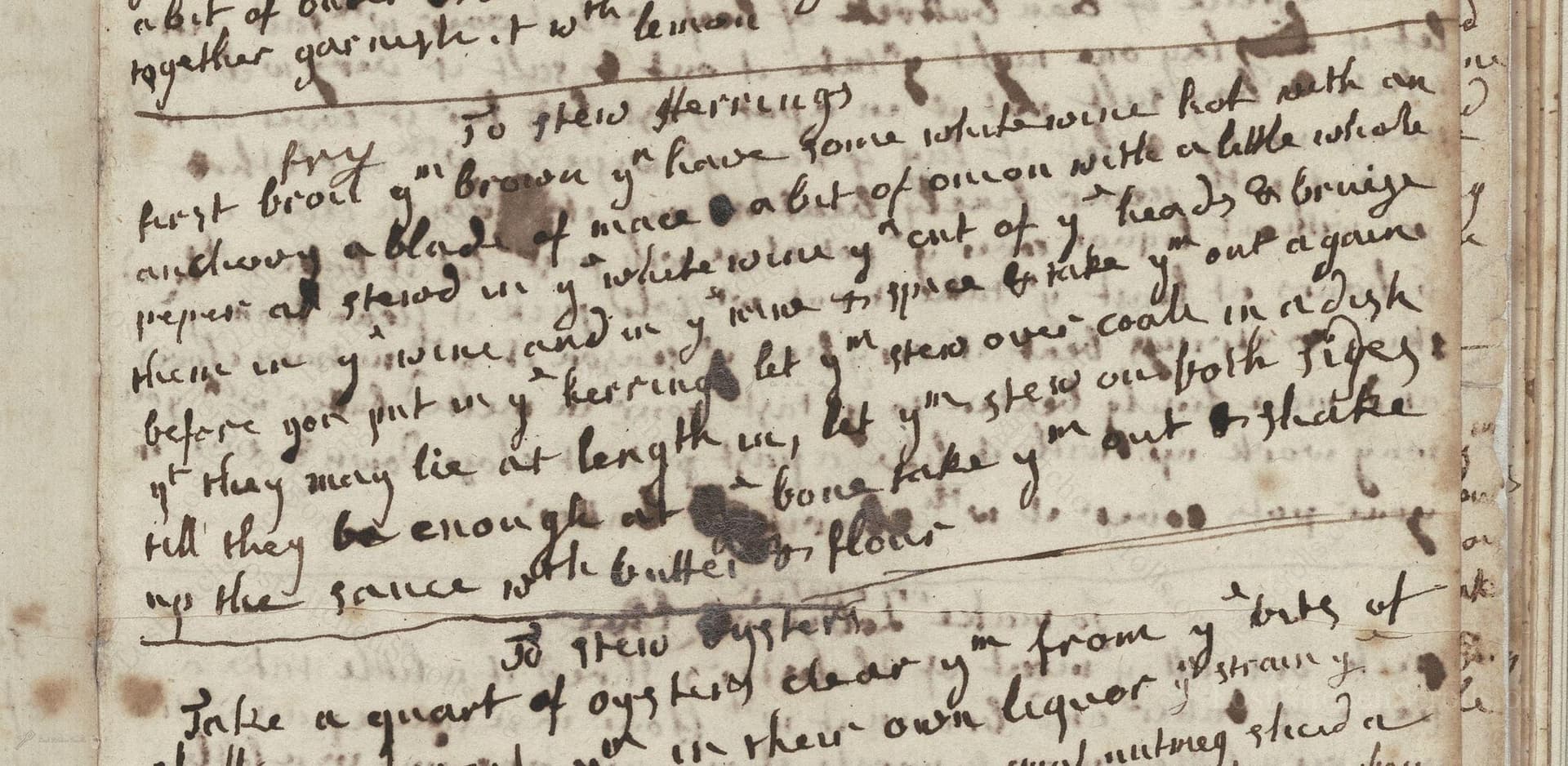To Stew Herrings
From the treasured pages of Mrs. Knight's receipt book
Written by Mrs. Knight

To Stew Herrings
"first broil ym brown you have some white wine hot with an anchovy a blade of mace a bit of pimon a whole peper and stewd in ye white wine ye heads & bruize them in ye wine & spice to make ye sauce then take ym out againe & let ym stew over ye coale in a dish before you put on ye sauce let ym stew on both sides then take ym out & shake up the sauce with butterr"
Note on the Original Text
This recipe is written in the abbreviation-heavy, phonetic style typical of early 18th-century English manuscripts. Punctuation was sparse, and words like 'ym' ('them') and 'ye' ('the') appear throughout, reflecting both regional pronunciation and evolving English spelling. Directions are more suggestive than prescriptive, relying on the cook's experience with times and quantities—common before standardized measurements and mass printing.

Title
Mrs. Knight's receipt book (1740)
You can also click the book image above to peruse the original tome
Writer
Mrs. Knight
Era
1740
Publisher
Unknown
Background
Step into the refined kitchens of 18th-century England with Mrs. Knight’s culinary collection, where time-honored recipes, hearty roasts, and elegant pastries await the enterprising cook.
Kindly made available by
Folger Shakespeare Library
This recipe comes from Mrs. Knight, active around 1740, at a time when English kitchens were bustling with both local and imported flavors. Fish stews such as this were a practical and tasty choice in coastal Britain, and herrings—abundant and inexpensive—show up in many period cookbooks. The recipe represents the transitional era when medieval spice-laden sauces met the emerging love affair with wine and seafood. The inclusion of butter and anchovy echoes the move towards savory richness in the Georgian kitchen.

In the 18th century, herrings would have been broiled over a wood or charcoal fire, likely on a wire gridiron or even skewered on toasting forks. The sauce would have been prepared in a small metal saucepan or pipkin, simmered gently over glowing coals. Cooks used wooden spoons to stir, with simple knives for preparing the fish. Butter was swirled in at the end, either by shaking the pan or with quick wrist action.
Prep Time
10 mins
Cook Time
20 mins
Servings
4
We've done our best to adapt this historical recipe for modern kitchens, but some details may still need refinement. We warmly welcome feedback from fellow cooks and culinary historians — your insights support the entire community!
Ingredients
- 4 fresh herrings, cleaned (reserve heads, remove innards)
- 1 anchovy, rinsed and drained (about 1/3 oz)
- 1 cup dry white wine
- 1 small blade mace (or 1/4 tsp ground mace as substitute)
- 1 small piece red pimiento or 1 dried mild chile or 1/2 tsp mild paprika
- 1 whole black peppercorn
- 1 oz unsalted butter
Instructions
- Begin by broiling (grilling) the herrings until they are nicely browned on both sides.
- Meanwhile, heat 1 cup of dry white wine in a small saucepan with 1 cleaned anchovy, 1 small blade of mace, a small piece of red pepper (substitute with a pinch of mild paprika or a small dried chile), and 1 whole black peppercorn.
- Add the herring heads to the wine, bruise them to help flavor the liquid, and simmer for 10 minutes to infuze the sauce with spices and fish flavor.
- Remove and discard the herring heads.
- Return the broiled herrings to a shallow dish and gently stew them over very low heat, turning on both sides, just to warm them throuh.
- Then, pour over the hot infused wine sauce.
- Finally, whisk in a generous knob of butter (about 1 oz), swirling the pan to make the sauce glossy and rich.
- Serve warm.
Estimated Calories
250 per serving
Cooking Estimates
It takes about 10 minutes to prepare the herrings and ingredients, and around 20 minutes to cook everything. Each person gets one herring as a serving, and each serving has about 250 calories.
As noted above, we have made our best effort to translate and adapt this historical recipe for modern kitchens, taking into account ingredients nowadays, cooking techniques, measurements, and so on. However, historical recipes often contain assumptions that require interpretation.
We'd love for anyone to help improve these adaptations. Community contributions are highly welcome. If you have suggestions, corrections, or cooking tips based on your experience with this recipe, please share them below.
Join the Discussion
Rate This Recipe
Dietary Preference
Main Ingredients
Occasions

Den Bockfisch In Einer Fleisch Suppen Zu Kochen
This recipe hails from a German manuscript cookbook compiled in 1696, a time whe...

Die Grieß Nudlen Zumachen
This recipe comes from a rather mysterious manuscript cookbook, penned anonymous...

Ein Boudain
This recipe comes from an anonymous German-language manuscript cookbook from 169...

Ein Gesaltzen Citroni
This recipe, dating from 1696, comes from an extensive anonymous German cookbook...
Browse our complete collection of time-honored recipes



